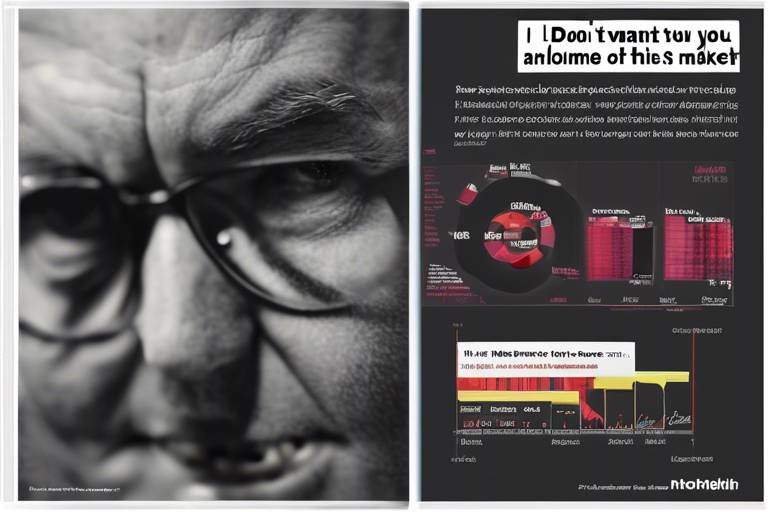How to Assess Market Sentiment Using Data Analytics
In today's fast-paced financial landscape, understanding market sentiment is more crucial than ever. It’s not just about numbers and charts; it’s about grasping the emotional pulse of the market. Market sentiment reflects the overall attitude of investors towards a particular market or asset, and it can be heavily influenced by various factors such as news, events, and social media chatter. By leveraging data analytics, we can decode these sentiments, allowing businesses and investors to make informed decisions that could significantly impact their strategies.
Imagine you're navigating a ship through turbulent waters. The waves represent market fluctuations, and the wind symbolizes public opinion. If you can read the wind, you can adjust your sails accordingly to steer your ship safely to port. This article will walk you through the methods and tools available for analyzing market sentiment through data analytics, providing you with insights into consumer behavior and market trends that enhance decision-making.
Market sentiment encompasses the collective feelings and attitudes of investors toward a market or asset. It’s like a mood ring for the financial world; it changes with the tides of news cycles, economic indicators, and social media trends. When investors are optimistic, they are more likely to buy, driving prices up. Conversely, when fear or uncertainty prevails, selling ensues, leading to price drops. Understanding these dynamics is essential for anyone looking to make sound investment choices.
To effectively assess market sentiment, identifying reliable data sources is paramount. Various platforms can provide valuable insights, including:
- Social Media: Real-time discussions and opinions from users.
- News Articles: Coverage of market events and economic indicators.
- Financial Reports: Company performance and forecasts.
These sources, when analyzed correctly, can reveal trends and shifts in sentiment that may not be immediately apparent through traditional financial analysis alone.
Social media platforms like Twitter and Facebook are treasure troves of real-time sentiment data. They allow us to tap into the collective consciousness of the public, offering insights that can influence market trends. For example, a trending hashtag about a particular stock can send ripples through the market, affecting its price. By leveraging social media analytics, investors can gauge public opinion, identify emerging trends, and even predict market movements before they happen.
Numerous tools are available for analyzing social media sentiment, ranging from basic keyword tracking to advanced machine learning algorithms. Some popular tools include:
| Tool Name | Description |
|---|---|
| Hootsuite | A social media management platform that offers sentiment analysis features. |
| Brandwatch | A powerful analytics tool that provides insights into consumer sentiment across various platforms. |
| Google Trends | Tracks search interest over time, providing a glimpse into public sentiment. |
These tools can help distill vast amounts of data into actionable insights, enhancing your ability to make informed decisions.
However, analyzing sentiment from social media is not without its challenges. The noise of misinformation and the sheer volume of data can be overwhelming. How do you sift through the chaos to find meaningful insights? Here are some strategies to mitigate these challenges:
- Data Filtering: Use algorithms to filter out noise and focus on relevant conversations.
- Contextual Analysis: Understand the context behind sentiments to avoid misinterpretations.
- Regular Updates: Continuously update your data sources to reflect the most current sentiment.
By addressing these challenges, you can enhance the accuracy of your sentiment assessments.
Traditional media sources, including news articles and financial reports, also significantly influence market sentiment. Analyzing these texts can provide valuable sentiment insights. For example, a positive earnings report can boost investor confidence, while negative news can trigger panic selling. By employing text analysis techniques, investors can extract sentiment from these sources to gauge market reactions effectively.
Market sentiment can be assessed through both quantitative data, such as stock prices, and qualitative data, like consumer opinions. While quantitative analysis provides hard numbers, qualitative analysis offers context and depth. Understanding the strengths and weaknesses of both approaches is essential for a well-rounded analysis.
Integrating both quantitative and qualitative data provides a more comprehensive view of market sentiment. By combining numerical data with consumer feedback, you can create a robust analysis that captures the full spectrum of market dynamics. For instance, a spike in stock prices paired with positive consumer sentiment can signal a bullish trend, while a decline in prices alongside negative sentiment may indicate a bearish outlook.
Understanding market sentiment through data analytics has various applications, including:
- Investment Strategies: Tailoring investment decisions based on sentiment trends.
- Marketing Campaigns: Crafting campaigns that resonate with consumer emotions.
- Risk Management: Identifying potential market downturns before they occur.
These practical uses demonstrate the power of sentiment analysis in real-world scenarios, ultimately enhancing decision-making and strategic planning.
1. What is market sentiment?
Market sentiment refers to the overall attitude of investors towards a particular market or asset, influenced by various factors such as news, events, and social media.
2. How can social media impact market sentiment?
Social media platforms provide real-time data on public opinion, which can influence market trends and investor behavior.
3. What tools are effective for sentiment analysis?
Tools like Hootsuite, Brandwatch, and Google Trends are popular for analyzing sentiment across social media and other platforms.
4. What are the challenges of social media sentiment analysis?
Challenges include noise and misinformation, requiring effective data filtering and contextual analysis to ensure accuracy.
5. How can sentiment analysis be applied in business?
Sentiment analysis can inform investment strategies, enhance marketing campaigns, and improve risk management practices.

Understanding Market Sentiment
Market sentiment is a term that captures the prevailing attitude of investors regarding a specific market or asset. Think of it as the collective mood of the market—are investors feeling optimistic, pessimistic, or somewhere in between? This sentiment is not just a passing trend; it is a vital component that influences market dynamics and investment strategies. Just like a weather forecast can help you decide whether to carry an umbrella or wear sunglasses, understanding market sentiment can guide investors in making informed decisions.
The factors that influence market sentiment are numerous and varied. They can range from macroeconomic indicators, such as employment rates and inflation, to micro-level events like a company's quarterly earnings report. However, the most significant drivers often come from news cycles and social media chatter. For instance, a tweet from a high-profile individual can send stock prices soaring or plummeting in a matter of minutes. This instantaneous reaction highlights the importance of keeping a pulse on public sentiment.
To further illustrate the impact of market sentiment, consider the following key influences:
- News Events: Major news stories, such as geopolitical tensions or natural disasters, can create waves of fear or optimism among investors.
- Social Media Buzz: Platforms like Twitter and Facebook serve as real-time barometers for public opinion, often influencing market movements.
- Economic Indicators: Reports on unemployment, consumer spending, and inflation can sway investor confidence significantly.
Understanding market sentiment is crucial for anyone involved in trading or investing. It can provide insights into potential price movements and help in formulating strategies that align with prevailing market attitudes. For example, if sentiment is overwhelmingly positive, investors might consider entering positions in anticipation of price increases. Conversely, if sentiment is negative, it might be prudent to either exit positions or adopt a more defensive stance.
Moreover, market sentiment can be both quantitative and qualitative. Quantitative sentiment is often derived from numerical data, such as trading volumes or price movements, while qualitative sentiment is more about the feelings and opinions expressed by consumers and investors. Both types of data are essential for a well-rounded understanding of market dynamics.
Ultimately, market sentiment serves as a compass for investors, guiding them through the often turbulent waters of financial markets. By analyzing sentiment, investors can better anticipate market movements, make informed decisions, and potentially enhance their investment outcomes. Whether you're a seasoned trader or a casual investor, tapping into the pulse of market sentiment can be a game-changer in your financial journey.

Data Sources for Sentiment Analysis
When it comes to assessing market sentiment, the quality of your data sources can make or break your analysis. Imagine trying to navigate through a dense fog without a reliable compass; that’s what it feels like to analyze sentiment without trustworthy data. The landscape of data sources is vast and varied, but some platforms stand out as particularly valuable in providing insights into consumer behavior and market trends.
First up, we have social media platforms. These sites are like bustling marketplaces where opinions are exchanged in real-time. Platforms like Twitter, Facebook, and Instagram are treasure troves of sentiment data, with users expressing their feelings about products, services, and market trends openly. By analyzing posts, comments, and hashtags, you can get a pulse on what people are genuinely thinking. However, it's essential to sift through the noise, as social media can also be a breeding ground for misinformation.
Next, we turn our attention to news articles and financial reports. These traditional media sources play a significant role in shaping public perception and market sentiment. A well-written article in a reputable financial publication can sway investor sentiment dramatically. By employing text analysis tools, you can extract sentiment indicators from these sources, helping you understand how news coverage influences market dynamics. For example, a sudden spike in negative news articles about a company can correlate with a drop in its stock price.
Moreover, market research reports and consumer surveys are invaluable for gathering qualitative insights. These reports often provide a deeper understanding of consumer attitudes and preferences, which can be crucial for businesses looking to tailor their products or marketing strategies. By analyzing survey data, you can gauge public sentiment towards a brand or product, helping you make informed decisions.
To summarize, the key data sources for sentiment analysis include:
- Social Media: Real-time opinions and trends.
- News Articles: Influences public perception and market movements.
- Financial Reports: Insights into investor sentiment.
- Market Research Reports: In-depth consumer insights.
- Consumer Surveys: Direct feedback from target audiences.
Utilizing a combination of these sources can provide a more rounded view of market sentiment. However, it's crucial to ensure that the data is not only abundant but also credible. The insights derived from these sources can empower you to make informed decisions, whether you’re an investor, marketer, or business owner. In the end, the right data can illuminate the path forward, helping you navigate the complex world of market sentiment.

Social Media Impact
In today's digital age, social media has become a powerful tool that shapes public perception and market sentiment. Platforms like Twitter, Facebook, and Instagram serve as bustling marketplaces of ideas, opinions, and emotions, where every post, tweet, or comment can influence investor behavior. Imagine walking into a crowded room where everyone is discussing a hot topic; the energy and opinions shared can sway decisions in real-time. This is precisely what happens on social media, where sentiments can shift dramatically based on trending topics or breaking news.
To effectively gauge market sentiment, businesses and investors must tap into these platforms. By monitoring conversations and analyzing the tone of posts, one can identify whether the mood is positive, negative, or neutral. For instance, a sudden influx of negative tweets about a company can indicate a potential downturn, while a wave of enthusiasm can signal a buying opportunity. But how do we go about extracting this valuable data?
Social media sentiment analysis involves several key components:
- Real-time Monitoring: Tools that track mentions and hashtags can provide insights into current public opinions.
- Sentiment Scoring: Algorithms can analyze the language used in posts to assign a sentiment score, helping to quantify feelings.
- Trend Analysis: Observing how sentiments change over time can reveal patterns that may affect market dynamics.
However, while social media offers a treasure trove of insights, it also presents challenges. The sheer volume of data can be overwhelming, and distinguishing genuine sentiment from noise—such as spam or misinformation—can be tricky. It’s akin to finding a needle in a haystack; the task requires robust tools and methodologies to sift through the clutter.
Moreover, the impact of social media sentiment can be immediate and far-reaching. For example, a viral post can lead to a rapid increase in stock prices, as seen with companies like GameStop during the infamous short squeeze event driven by Reddit users. This illustrates that understanding social media sentiment is not just an academic exercise; it has real-world implications that can make or break investment strategies.
In conclusion, leveraging social media for sentiment analysis is crucial for anyone looking to stay ahead in the market. By understanding the nuances of public sentiment and employing the right tools, businesses can make informed decisions that align with consumer perceptions and market trends.
- What is market sentiment? Market sentiment refers to the overall attitude of investors towards a particular market or asset, influenced by various factors including news and social media.
- How can social media impact market sentiment? Social media can rapidly influence public opinion, leading to immediate changes in market behavior based on trending discussions and posts.
- What tools can I use for sentiment analysis? There are many tools available, ranging from basic keyword trackers to sophisticated machine learning algorithms designed to analyze sentiment in real-time.
- What are the challenges of analyzing social media sentiment? Challenges include dealing with misinformation, noise, and the sheer volume of data that can make it difficult to extract clear insights.

Sentiment Analysis Tools
In the realm of sentiment analysis, having the right tools at your disposal can make all the difference. These tools help you sift through vast amounts of data, extracting valuable insights that can inform your investment decisions and marketing strategies. From basic keyword tracking to sophisticated machine learning algorithms, the landscape of sentiment analysis tools is as diverse as the data they process.
One of the most popular tools for sentiment analysis is Lexalytics. This platform uses natural language processing (NLP) to analyze text data from various sources, including social media, news articles, and customer reviews. Lexalytics can provide sentiment scores, themes, and even entity recognition, giving you a comprehensive view of public sentiment towards your brand or product.
Another noteworthy tool is Brandwatch. This robust social media analytics platform allows users to monitor brand mentions across multiple channels, offering insights into consumer sentiment in real time. With its advanced filtering options and customizable dashboards, Brandwatch empowers businesses to track sentiment trends and respond proactively to shifts in public opinion.
For those looking for a more DIY approach, Google Cloud Natural Language API is an excellent option. This tool enables users to analyze text for sentiment, entity recognition, and syntax, making it a versatile choice for developers and analysts alike. Its integration capabilities with other Google services also make it a popular choice for organizations already using the Google ecosystem.
To give you a clearer picture of how these tools compare, here's a brief overview in the table below:
| Tool | Key Features | Ideal For |
|---|---|---|
| Lexalytics | NLP, sentiment scoring, entity recognition | Brands seeking comprehensive text analysis |
| Brandwatch | Real-time monitoring, customizable dashboards | Businesses focused on social media sentiment |
| Google Cloud Natural Language API | Sentiment analysis, entity recognition, syntax analysis | Developers and analysts looking for flexibility |
While these tools are powerful, it's essential to remember that no tool is perfect. Each one comes with its own set of limitations, such as language support or the ability to handle sarcasm and idiomatic expressions. Therefore, it's crucial to choose the right tool based on your specific needs and the type of data you plan to analyze.
Ultimately, the effectiveness of sentiment analysis tools hinges not just on their capabilities but also on how well you utilize them. By combining the insights gained from these tools with your market knowledge and intuition, you can make more informed decisions that resonate with your target audience.

Challenges in Social Media Analysis
When diving into the vast ocean of social media data, one quickly realizes that it’s not all smooth sailing. Analyzing sentiment from platforms like Twitter and Facebook presents a myriad of challenges that can complicate the process. One of the most significant hurdles is the sheer volume of data. Every second, thousands of posts are created, and sifting through this noise to extract meaningful insights can feel like finding a needle in a haystack.
Another major challenge is the presence of misinformation and noise. Social media is a breeding ground for rumors and misleading information. For instance, a single tweet can go viral and skew public perception, leading to distorted sentiment analysis. To combat this, analysts must develop strategies to filter out unreliable sources and focus on credible data. This often involves employing advanced algorithms that can discern between genuine sentiment and deceptive content.
Moreover, the context in which a statement is made can dramatically alter its meaning. Sarcasm, irony, and cultural references can obscure the true sentiment behind a post. For example, a tweet that reads, “Great, another Monday!” could be interpreted as positive or negative depending on the context. This ambiguity requires sophisticated natural language processing tools that can understand the nuances of human language.
Additionally, the dynamic nature of social media poses a challenge. Trends can change at lightning speed, and what was once a hot topic can quickly fade into obscurity. Analysts must remain vigilant and continuously update their data analysis models to reflect these shifts. This requires not only technical expertise but also a keen understanding of current events and cultural trends.
Finally, there’s the issue of privacy and ethical considerations. With growing concerns about data privacy, analysts must tread carefully when collecting and analyzing social media data. Ensuring compliance with regulations like GDPR is essential to maintain trust and credibility.
In summary, while social media offers a wealth of sentiment data, the challenges it presents cannot be overlooked. By understanding these obstacles and employing effective strategies to mitigate them, analysts can harness the power of social media to gain valuable insights into market sentiment.
- What is market sentiment? Market sentiment refers to the overall attitude of investors towards a particular market or asset, influenced by various factors.
- Why is social media important for sentiment analysis? Social media platforms provide real-time data and reflect public opinion, making them valuable for understanding market sentiment.
- What are the main challenges in analyzing social media data? The main challenges include data volume, misinformation, context ambiguity, dynamic trends, and privacy concerns.

News and Financial Reports
When it comes to assessing market sentiment, news articles and financial reports are invaluable resources. They serve as the pulse of the market, capturing the collective mood of investors and consumers alike. Imagine walking into a bustling café; the conversations and laughter give you a sense of the atmosphere. Similarly, news and financial reports provide insights into how the market is feeling at any given moment, influenced by various factors such as economic indicators, corporate earnings, and geopolitical events.
News articles often cover a wide range of topics that can sway market sentiment, including:
- Economic forecasts
- Major corporate announcements
- Government policies and regulations
- Global events and crises
For instance, a report on a significant drop in unemployment rates might boost investor confidence, leading to a surge in stock prices. Conversely, news of a natural disaster affecting a major industry could lead to panic selling. Therefore, staying updated with reliable news sources is crucial for anyone looking to understand market dynamics.
Financial reports, particularly quarterly earnings reports, are another critical component of sentiment analysis. These documents provide a detailed look at a company's performance, revealing insights into revenue, profit margins, and future projections. Investors often react strongly to these reports, and the sentiment can shift dramatically based on whether a company meets, exceeds, or falls short of expectations. To illustrate this, consider the following table that summarizes typical market reactions to earnings reports:
| Performance | Market Reaction |
|---|---|
| Exceeds Expectations | Stock Price Surge |
| Meets Expectations | Stable or Slight Increase |
| Falls Short of Expectations | Stock Price Drop |
However, it's not just about the numbers. The tone and language used in news articles and financial reports can also impact sentiment. For example, a report that emphasizes optimism and growth can foster a positive outlook, while one filled with caution and uncertainty may lead to a more bearish sentiment. This is where sentiment analysis tools come into play, helping analysts dissect the language used in these reports to gauge overall market sentiment.
In conclusion, news articles and financial reports are integral to understanding market sentiment. They provide a wealth of information that can influence investor behavior, making it essential for anyone involved in the market to pay close attention to these sources. By analyzing the content and context of these reports, investors can make more informed decisions, ultimately leading to better investment strategies and outcomes.
Q: How can I use news and financial reports to assess market sentiment?
A: By regularly reading reliable news sources and analyzing financial reports, you can gauge investor sentiment based on the information presented. Look for trends in language and tone, as well as key economic indicators that may affect market behavior.
Q: Are there specific tools for analyzing sentiment in news articles?
A: Yes, there are various sentiment analysis tools available that can help you analyze the tone and sentiment of news articles, such as Natural Language Processing (NLP) tools that can quantify sentiment scores based on the language used.

Quantitative vs. Qualitative Analysis
When it comes to assessing market sentiment, two primary approaches dominate the landscape: quantitative analysis and qualitative analysis. Each method offers unique insights and serves different purposes in understanding consumer behavior and market trends. But what exactly distinguishes these two approaches? Think of quantitative analysis as the hard facts and figures—like the numbers on a balance sheet—while qualitative analysis is more about the stories behind those numbers, akin to the emotions and motivations that drive consumer decisions.
Quantitative analysis relies on measurable data, often represented through statistics and numerical values. For example, stock prices, trading volumes, and economic indicators provide a wealth of information that can be analyzed to identify trends. This approach is particularly useful for investors looking to make data-driven decisions based on historical performance and market patterns. In contrast, qualitative analysis digs deeper into the human element of market sentiment. It examines opinions, feelings, and perceptions, often gathered through surveys, interviews, or social media monitoring. By understanding the context behind the numbers, analysts can gain a more nuanced view of market dynamics.
To illustrate the differences between these two methods, consider the following table:
| Aspect | Quantitative Analysis | Qualitative Analysis |
|---|---|---|
| Data Type | Numerical | Descriptive |
| Tools Used | Statistical software, spreadsheets | Surveys, interviews, content analysis |
| Focus | Trends and patterns | Motivations and emotions |
| Outcome | Data-driven insights | Contextual understanding |
Both approaches have their strengths and weaknesses. For instance, quantitative analysis can provide a clear picture of market trends but may overlook the emotional factors that influence consumer behavior. On the other hand, while qualitative analysis can uncover deep insights into consumer sentiment, it may lack the statistical rigor needed for broader market predictions. Therefore, the key is not to view these methods as mutually exclusive but rather as complementary tools in the analyst's toolkit.
In practice, many successful analysts advocate for a combined approach. By integrating both quantitative and qualitative data, they can create a more comprehensive view of market sentiment. For example, an investor might analyze stock price movements (quantitative) while also monitoring social media sentiment about a company’s latest product launch (qualitative). This dual approach allows for a richer understanding of market dynamics, leading to more informed decision-making.
In summary, while quantitative and qualitative analyses each have their unique contributions to market sentiment assessment, leveraging both can provide a more holistic view. This integrated perspective not only enhances the accuracy of predictions but also helps in crafting strategies that resonate with consumer sentiments, ultimately leading to better outcomes in investment and marketing efforts.
- What is market sentiment? Market sentiment refers to the overall attitude of investors towards a particular market or asset, influenced by various factors including news and social media.
- How can I measure market sentiment? Market sentiment can be measured through various methods, including quantitative data analysis and qualitative insights from consumer opinions.
- Why is combining quantitative and qualitative analysis important? Combining both approaches provides a more comprehensive understanding of market sentiment, enhancing decision-making and strategy formulation.
- What tools can I use for sentiment analysis? There are numerous tools available, ranging from social media analytics platforms to statistical software for quantitative analysis.

Combining Data Types
In the realm of market sentiment analysis, the phrase "the whole is greater than the sum of its parts" truly resonates. When it comes to understanding consumer behavior and market trends, relying solely on either quantitative or qualitative data can lead to a skewed perspective. By , analysts can create a more holistic view that captures the nuances of market sentiment. Imagine trying to navigate a ship using only one compass; it’s possible, but you’d likely miss out on vital information that could steer you clear of danger. This is why integrating diverse data sources is crucial.
Quantitative data, such as stock prices and trading volumes, provides hard numbers that can reveal trends and patterns. However, these figures alone may not tell the full story. For instance, a sudden spike in stock prices might seem positive, but without understanding the underlying consumer sentiment—perhaps fueled by a viral social media post or a recent news article—the analysis remains incomplete. This is where qualitative data shines. Insights gathered from consumer opinions, reviews, and social media interactions can provide context that numbers alone cannot offer.
To effectively combine these data types, analysts often employ a variety of methodologies. One popular approach is to use sentiment analysis tools that can quantify qualitative data, turning subjective opinions into measurable metrics. For example, tools like Lexalytics or MonkeyLearn can analyze text from social media posts, extracting sentiment scores that can then be compared with quantitative financial data. This combination allows analysts to see not just what is happening in the market, but also why it is happening.
Furthermore, the integration of these data types can enhance predictive modeling. By correlating changes in sentiment with historical market performance, analysts can develop predictive algorithms that provide valuable insights for future market movements. For instance, if a particular product receives overwhelmingly positive feedback on social media, it might lead to a forecast of rising stock prices for the company producing it. Conversely, a surge in negative sentiment could signal potential downturns.
In practice, combining data types can be visualized through dashboards that display both quantitative metrics and qualitative insights side by side. This allows stakeholders to make informed decisions based on a comprehensive understanding of market dynamics. For example, a dashboard might show:
| Data Type | Metric | Sentiment Score |
|---|---|---|
| Stock Price | $150 | +0.75 |
| Volume of Mentions | 10,000 | +0.60 |
| Customer Reviews | 4.5/5 | +0.80 |
This table illustrates how different data types can be aligned to provide a clearer picture of market sentiment. By analyzing the interplay between stock prices, social media mentions, and customer reviews, analysts can draw more nuanced conclusions about market conditions.
In summary, the art of combining quantitative and qualitative data is not just a technique; it's a strategic advantage in the ever-evolving landscape of market sentiment analysis. By embracing a multifaceted approach, analysts can uncover deeper insights that drive better decision-making, ultimately leading to enhanced investment strategies and more effective marketing campaigns.
- What is the importance of combining data types in market sentiment analysis?
Combining data types allows for a more comprehensive understanding of market dynamics, capturing both numerical trends and consumer emotions. - How can qualitative data be quantified?
Qualitative data can be quantified using sentiment analysis tools that convert text into sentiment scores, making it easier to compare with quantitative metrics. - What tools can help in combining data types?
Tools like Lexalytics and MonkeyLearn are popular for sentiment analysis, while visualization dashboards can help display combined data effectively.

Applications of Sentiment Analysis
Understanding market sentiment through data analytics opens up a treasure trove of opportunities for businesses and investors alike. By tapping into the emotional pulse of the market, organizations can make informed decisions that align with consumer expectations and market trends. This is not just about crunching numbers; it’s about interpreting feelings, attitudes, and opinions that drive market behavior. Imagine being able to predict the next big trend just by observing the chatter online! Here are some of the key applications where sentiment analysis can make a significant impact:
1. Investment Strategies: Investors can utilize sentiment analysis to gauge the mood of the market before making investment decisions. By analyzing social media posts, news articles, and financial reports, they can identify bullish or bearish sentiments surrounding specific stocks or sectors. For instance, if a majority of tweets about a tech company are positive, it might signal a good investment opportunity. Conversely, a surge in negative sentiment could indicate potential risks.
2. Marketing Campaigns: In the world of marketing, understanding consumer sentiment can be a game-changer. Brands can tailor their marketing strategies based on the sentiments expressed by their target audience. For example, if a product receives favorable reviews and positive mentions on social media, brands can amplify that message through targeted advertising. Conversely, if there’s a wave of negative feedback, companies can pivot their strategies to address consumer concerns, enhancing brand loyalty.
3. Risk Management: Companies can also leverage sentiment analysis to identify potential risks. By monitoring public sentiment regarding regulatory changes or economic conditions, businesses can proactively adjust their strategies to mitigate risks. For example, if sentiment analysis reveals growing public concern over environmental issues, companies in that sector might consider adopting more sustainable practices to align with consumer expectations.
4. Product Development: Sentiment analysis can provide valuable insights into consumer preferences and trends, guiding product development. By analyzing feedback on existing products, companies can identify features that resonate well with consumers and those that do not. This data-driven approach enables organizations to innovate and create products that meet market demand effectively.
5. Customer Service Improvement: Monitoring sentiment can also enhance customer service. By analyzing feedback from customer interactions, companies can pinpoint areas for improvement. If customers frequently express frustration over a specific issue, businesses can address it promptly, leading to higher customer satisfaction and retention rates.
In summary, the applications of sentiment analysis span across various domains, from investment strategies to product development and customer service. The ability to understand and respond to market sentiment not only enhances decision-making but also fosters a deeper connection between brands and consumers. As we move forward, the integration of sentiment analysis into business strategies will likely become even more critical in navigating the complexities of the market.
- What is sentiment analysis? Sentiment analysis is the process of assessing public opinion or emotional tone behind a series of words, often used to understand consumer sentiments towards products, brands, or market conditions.
- How can businesses benefit from sentiment analysis? Businesses can gain insights into customer preferences, improve marketing strategies, manage risks, and enhance product development by understanding market sentiment.
- What tools are commonly used for sentiment analysis? There are various tools available, including social media monitoring platforms, natural language processing (NLP) tools, and data analytics software that help analyze sentiment across different data sources.
- Are there any challenges in sentiment analysis? Yes, challenges include dealing with noise in data, distinguishing between sarcasm and genuine sentiment, and managing misinformation that can skew results.
Frequently Asked Questions
- What is market sentiment?
Market sentiment refers to the overall attitude of investors towards a specific market or asset. It is shaped by various factors like news, events, and social media discussions, reflecting how people feel about the current state of the market.
- Why is understanding market sentiment important?
Understanding market sentiment is crucial because it influences market dynamics and investment strategies. By gauging how investors feel, you can make more informed decisions, whether you're buying, selling, or holding assets.
- What are some reliable data sources for sentiment analysis?
Reliable data sources for sentiment analysis include social media platforms, news articles, financial reports, and market research studies. These sources provide valuable insights into public opinion and market trends.
- How can social media impact market sentiment?
Social media platforms like Twitter and Facebook serve as real-time barometers of public opinion. They allow analysts to track trends, gauge consumer sentiment, and identify emerging market movements based on public discussions and reactions.
- What tools are available for sentiment analysis?
There are numerous tools available for sentiment analysis, ranging from basic keyword tracking software to advanced machine learning algorithms. Popular tools include Brandwatch, Hootsuite, and Google Trends, each offering unique functionalities for analyzing sentiment.
- What challenges do analysts face in social media sentiment analysis?
Analysts often encounter challenges such as noise, misinformation, and the complexity of human emotions expressed online. To mitigate these issues, it's essential to employ robust algorithms and contextual understanding when analyzing social media data.
- How do news and financial reports influence market sentiment?
News articles and financial reports can significantly sway market sentiment by shaping perceptions of economic conditions, company performance, and future prospects. Analyzing these texts helps investors understand the broader market context.
- What is the difference between quantitative and qualitative analysis?
Quantitative analysis focuses on numerical data, such as stock prices and trading volumes, while qualitative analysis examines non-numerical data, like consumer opinions and sentiments. Both approaches provide valuable insights but serve different purposes in market assessment.
- How can combining data types enhance sentiment analysis?
Combining quantitative and qualitative data offers a more comprehensive view of market sentiment. By integrating numerical data with consumer insights, analysts can develop richer interpretations and more accurate forecasts about market trends.
- What are the practical applications of sentiment analysis?
Sentiment analysis can be applied in various areas, including investment strategies, marketing campaigns, and risk management. By understanding market sentiment, businesses and investors can make better decisions that align with consumer expectations and market movements.



















